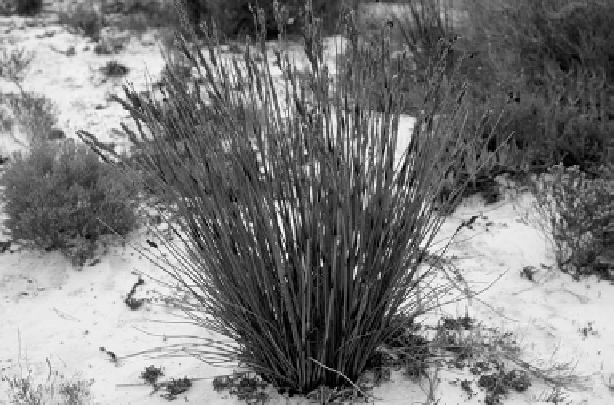Agriculture Reference
In-Depth Information
Fig. 7.6
One of the typical fynbos graminoids in the Restionaceae family on nutrient-poor
quartzite soil. (Photo by Jon Keeley.)
tissues or root suckering. The incidence of root suckering is poorly known but
does occur in several shrubby species such as
Cliffortia ruscifolia
where a single
clone may cover several hectares. Clonal spread by underground rhizomes is also a
distinctive feature of several aggressive graminoids, including species of
Restionaceae (
Fig. 7.6
). Finally, a few woody species resprout from epicormic
buds on branches that survive the fire (e.g.
Protea nitida
) but this is very rare in
fynbos, in contrast to Australian
Banksia
. Fynbos grasses have remarkably diverse
vegetative morphologies, linked to different fire responses, with greater diversity
of forms than in grassland or savanna biomes (Linder & Ellis
1990
). They include
fire ephemerals, geophytes and tall bamboo-like shrubby forms able to outcom-
pete woody species.
Obligate seeding life histories are very common in the fynbos flora with about
2000 species reported (Cowling
et al.
1997a
). Most of these are ericoid shrubs;
indeed, the genus
Erica
has over 600 species and the majority are obligate seeding
shrubs endemic to the Cape Floristic Region (Ojeda
1998
). Obligate seeding
proteoid shrubs form the overstory and dominate the biomass of many fynbos
communities. Obligate seeding graminoids also occur, making up an estimated
20% of the 550 species of grasses, restios and sedges (Cowling
et al.
1997a
). Most
(> 80%) fire ephemerals, which usually die out before the next fire, do not
resprout even if they survive long enough to burn.
Obligate resprouters are shrubs that regenerate after fire solely by resprouting and
do not recruit seedlings (see
Chapter 9
), a growth form dominant in Mediterranean
Basin and Chilean matorral and frequent in California chaparral, but very rare in
the fynbos with only 100 species (< 2% of the flora). However, these obligate
resprouters are common in Cape ecosystems, such as strandveld, thicket and

